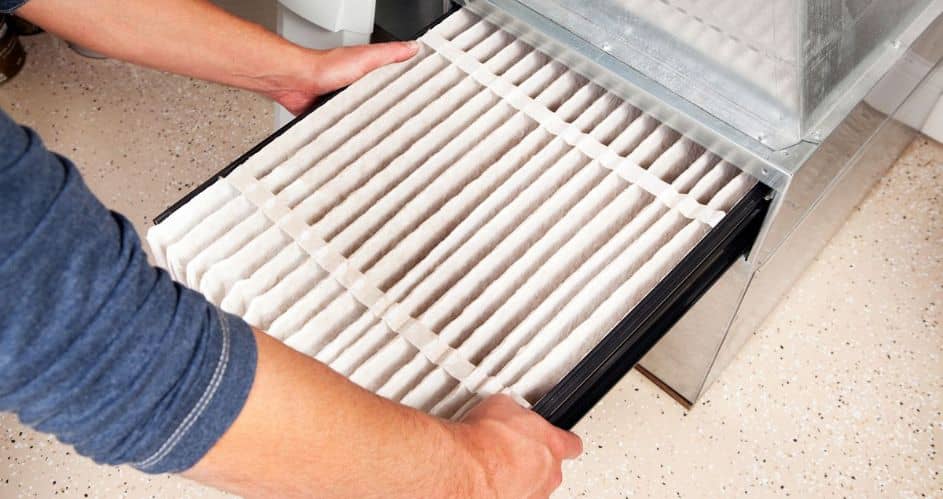
Your home maintenance list includes many items that need to be completed regularly. Simple household chores that ensure your house is comfortable and functional include sweeping floors, cutting the grass, and shoveling snow.
Furnace air filter replacement is another essential home maintenance task every homeowner should know.
The air filter becomes clogged with hair, grime, and other materials. Airflow through the filter and into the house may be restricted due to clogging over time. This lowers air quality and has a detrimental effect on your heating and cooling system’s efficiency.
An air filter:
Pleated paper and spun fiberglass are the two most popular domestic air filters. Its fame stems from its design to capture mildew, bacteria, lint, dust, grime, and pet hair.
The furnace’s filter may allow you to breathe clean air in your home. This is particularly crucial in households with people who have respiratory or allergy problems.
Finding the air filter already installed in your home is the simplest method for discovering an appropriate replacement. Measure the dimensions of the current air filter by looking at its sides. Then, find an air filter that fits the specified dimensions online or at your neighborhood home improvement store.
What does a furnace filter do?
Your furnace filter is famous for capturing airborne pollutants. It does it to purify your air. That’s not what it does, primarily as people think today.
They are designed not to improve air quality but to catch airborne contaminants.
As a result, those contaminants don’t enter your heating and cooling system. This is the primary purpose of furnace filters. Still, air quality gains from removing impurities because the filter does so for the system’s benefit.
How can You tell whether the filter in my furnace needs to be changed?
Despite its diminutive size and strength, the furnace filter is essential to the general operation of your HVAC system. When troubleshooting an HVAC system, changing the filter is frequently the first step. Signs indicating the need to change your furnace filter include any of the following:
- An increase in the cost of your heating and cooling
- You’re smelling something odd.
- Even though your furnace is operating longer, the temperature drops.
- When There’s more hair, remains, and dust swirling around.
Check the filter if any of the questions above arise. If it has turned grey and is coated with lint and dust, it should be replaced immediately.
How Frequently should you think about changing the furnace filter?
When learning about how often to change furnace filters, understand that the frequency of furnace filter replacements varies from home to home. The type of furnace filter used will determine how frequently this activity needs to be completed.
Several options are available in the filter replacement section of your preferred hardware shop. Many types of filters can affect how frequently you change them.
Furnace filter replacement is a monthly or annual task. As is the interval between filter replacements, a wide selection of filters is available. Fortunately, replacing furnace filters is a simple process.
You should be conscious of size; therefore, the first step is to estimate how frequently you should change the furnace filters. Five-inch filters need fewer changes than one-inch filters.
The reason is that the inch is bigger media, as it can collect more contaminants. The filter efficiency metric, known as minimum efficiency reporting value, will also influence.
Read these to learn how you should replace filters in terms of months:
- Every one to three months, replace 1- to 2-inch filters.
- Every six to nine months, change 3- to 4-inch filters.
- Replacing 5 to 6-inch filters every 9 to 12 months is better.
- Factors Dictate the frequence you need to replace your filters:
- There are a few factors that can determine the frequency to replace your filter:
The number of members in a home:
The number of people residing in the house impacts a furnace filter’s usable service life. Compared to single- or two-person households, furnace filters must be changed more frequently in large households.
Various toxins are brought into the home, so the more people living there, the more contaminants your filter will need to capture.
Consider the pet animals:
Another significant source of pollutants in the indoor air is pets. Air currents carry pet dander and fur, and the HVAC system distributes them throughout the house.
The lifespan of a filter decreases by approximately 30 days for every pet household member. It says that you will need to change your furnace filter more often.
Allergies:
Remember to replace the furnace filter regularly if you have asthmatic family members. This will ensure your home has clean air, benefiting your asthmatic family.
Usage of Heating and Cooling:
Since air is cycled more frequently when your home’s heating and cooling systems are in high use, filters have a shorter usable life due to the increased opportunity for impurities to accumulate and clog them.
Furnace filters are usually changed more frequently by homeowners in the summer and winter than in the fall and spring.
Quality of Indoor Air
Your furnace filter will only last for a short time in a house with good indoor air quality if you have problems with indoor air quality.
In houses without indoor air quality equipment, the furnace filter is the sole line of defense against airborne contaminants, so the filter fills up faster.
Indoor air quality equipment, such as air purifiers and air cleaners, reduces contaminant volume so there are fewer particles for your furnace filter to absorb.
Bottom Line:
Maintaining clean air quality and a well-functioning HVAC system requires routine furnace filter changes. The above points provide effective insights regarding how often change furnace filter.
For instance, if you have a small family with a single pet, you might change out a 1-inch filter every two months. To keep everything in peak condition, always check your filter once a month and replace it when it seems dirty.
